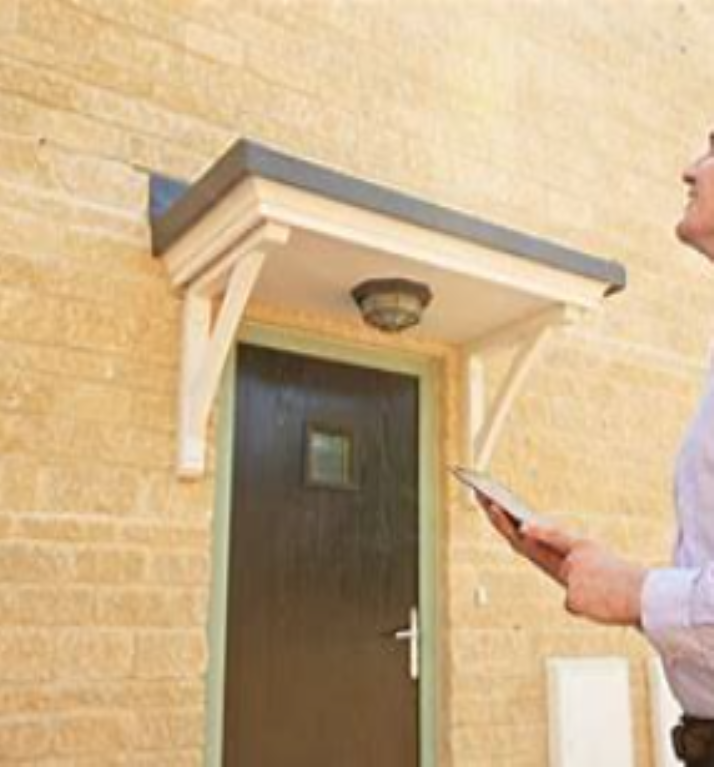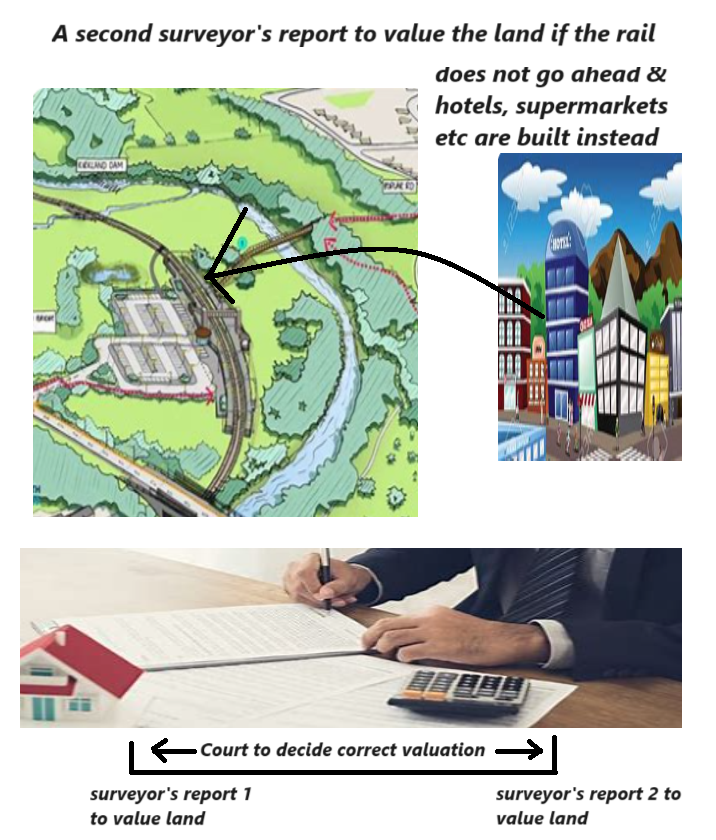Secretary of State for Transport v Curzon Park Ltd & Ors [2023] UKSC 30 (10 August 2023)
Citation: Secretary of State for Transport v Curzon Park Ltd & Ors [2023] UKSC 30 (10 August 2023)
Rule of thumb: Stare-decisis: If your home is being compulsorily purchased for a new public development, such as an HS2 rail link, should you use the Government’s surveyor’s report for the value of your home & the land, or, should you get your own surveyor’s report? You can get your own surveyor’s report to value of the land – the Government surveyor’s valuation for the land may be based on the Government project going ahead, but your own surveyor’s report will focus on the increased value of the land if it does not go ahead & so new planning permissions for homes, supermarkets, officers etc are obtained so that the land can be sold-off to developers, which may be bigger than the value of the Government’s surveyor’s report for the public project going ahead.
Background facts:The facts of this case were that the secretary of state for transport made a compulsory purchase of land in Birmingham for the ‘actual’ proposed HS2 rail transport project.
The Government obtained ‘actual’ planning permission for the transport project to take place on the land – the Government then obtained a surveyor’s report for the value of each house & the land with that planning permission, and made an offer to the homeowners.
The people whose houses were being compulsorily purchased formed a group, and they sought to add further ‘prospective’ land uses for the plot of land in case the project got scrapped in a CAAD (Certificate of Appropriate Alternative Development) – the homeowners then obtained their own surveyor’s report & sought an increased value with additional ‘prospective’ planning permission uses.
The Government & the homeowners could not agree on which valuation was correct – the ‘actual’ valuation with HS2 going ahead or the ‘prospective’ valuation with ‘offices’, ‘hotels’ etc going ahead - so the matter proceeded to Court.




Parties argued: The Government argued that virtually all of the ‘actual’ prospective transport projects go through, and so the additional value sought from the other ‘prospective’ land-uses was irrelevant and not to be taken into account in the valuation of the land – people should not be getting paid a value for their land which it is not being used for so the value does not exist in the real world.
The homeowners argued that some transport projects do fall through (projects take ages to start then new Governments come in & cancel them), and that the land then gets new planning permissions obtained for it, meaning it can be then be sold off by the Government to developers for an absolute fortune leading to the Government making a big profit on the land which homeowners do not see any of – with the transport ending up being much ado about nothing & the Government making all the profit on the land - the homeowners therefore argued that they had the right to share in this opportunity for other ‘prospective’ uses.
The valuation Courts accepted the homeowners’ position, so the Government appealed.
Court held: The Court upheld the homeowners' position to some degree – they argued that it is important for the land-valuers to set both valuations, the value of the land with the ‘actual’ planning permission & the value of the land with the ‘prospective’ planning permission like HS2 going ahead, then consider what the statistical % chances of the ‘actual’ public project going ahead & factor this into the valuation of the land – with the price being a % in between the ‘actual’ & ‘prospective’ valuations for the valuer & the Court to decide.

Ratio-decidendi:
1. ‘When land is compulsorily purchased the landowner is entitled to compensation. The basic measure of compensation is the open market value of land if sold by a willing seller - see rule (2) of section 5 of the Land Compensation Act 1961 (“the LCA”).
2. The landowner is also entitled to be compensated for enhancement of the value of the land (which we will call “the land in issue”) resulting from actual or prospective planning permission for its development. This is addressed in section 14 of the LCA.
3. Under section 14 in assessing the value of the land in issue account may be taken of (i) planning permission which is in force in respect of it at the relevant valuation date (section 14(2)(a)); (ii) the prospect at the valuation date of planning permission being granted in respect of it on or after that date (section 14(2)(b)) (commonly referred to as “hope value”); and (iii) “appropriate alternative development” of the land (section 14(3) and (4))…
13. Each of the respondents applied to Birmingham City Council (“the Council”), as the local planning authority, for a CAAD.
14. In relation to Site 1, the second respondent made a CAAD application to the Council on 11 February 2019. On 29 May 2019 the Council purported to grant a CAAD for a mixed-use development of up to 99,490 sqm including residential, office, hotel and retail uses, together with student accommodation providing 1,940 beds (because an appeal had already been lodged against the Council’s failure to determine the application within the statutory time limit, the parties agreed that the Council had no power to grant that CAAD, but it was indicative of the Council’s view).
15. In relation to Site 2, the fourth respondent made a CAAD application on 21 December 2018. On 31 July 2019 the Council granted a CAAD for a mixed use development of up to 88,829 sqm, including up to 895 dwellings, a maximum of 38,580 sqm of offices, a theatre and a concert hall, a hotel, car parking and a maximum of 66,187 sqm of student accommodation providing 2,279 beds.
16. In relation to Site 3, the first respondent made a CAAD application on 18 April 2019. On 18 June 2019 the Council granted a CAAD for a series of buildings of between 7 and 41 storeys comprising up to 181,260 sqm of residential, office, retail and educational uses, a hotel, and up to 37,013 sqm of student accommodation providing 1,716 beds.
17. In relation to Site 4, the third respondent made an initial application for a CAAD on 22 February 2019 and, following an appealed non-determination, a second application on 21 November 2019. On 16 January 2020 the Council granted a CAAD for a mixed-use development of up to 30,747 sqm and a maximum of 24,870 sqm of student accommodation providing 871 beds…
70. By virtue of section 14(2)(a), when assessing the value of the land in issue at the valuation date, account may be taken of any planning permission, whether for development of the land in issue or for development of other land, which is in force in the real world at that date. Therefore, if in the real world planning permission has been granted in respect of neighbouring land, that permission may be capable of affecting the assessment under section 14(4)(b) on the basis of the alternative sites, cumulative impact and incompatibility points and the principle of consistency referred to above (as it applies in relation to planning permission granted in respect of a different site). The existence of such planning permission will be known to the market on that date. There may also be scope for the principle of consistency to apply by reference to planning permission in effect at the valuation date in the real world in respect of the land in issue (ie by reference to planning permission granted in respect of the same site).
99. Where planning permissions exist in the real world in respect of either the land in issue or other land as at the valuation date for the land in issue (see section 14(2)(a)), the market in the counterfactual cancelled scheme world would expect the consistency principle to apply (insofar as it is relevant) in relation to an assessment whether planning permission would be granted for the land in issue, as mentioned in paras 70 and 72 above’.
Lord Sales
Warning: This is not professional legal advice. This is not professional legal education advice. Please obtain professional guidance before embarking on any legal course of action. This is just an interpretation of a Judgment by persons of legal insight & varying levels of legal specialism, experience & expertise. Please read the Judgment yourself and form your own interpretation of it with professional assistance.

